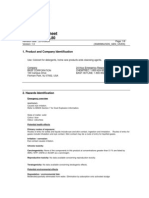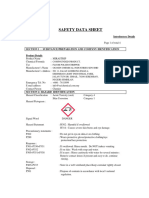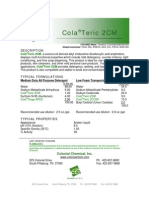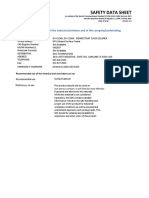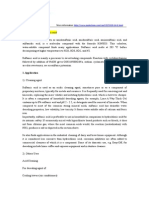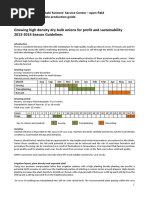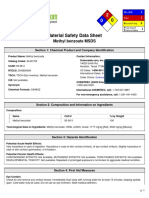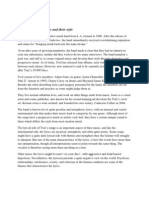Safety Data Sheet: Section 1. Identification
Safety Data Sheet: Section 1. Identification
Uploaded by
Toghrul dddCopyright:
Available Formats
Safety Data Sheet: Section 1. Identification
Safety Data Sheet: Section 1. Identification
Uploaded by
Toghrul dddOriginal Title
Copyright
Available Formats
Share this document
Did you find this document useful?
Is this content inappropriate?
Copyright:
Available Formats
Safety Data Sheet: Section 1. Identification
Safety Data Sheet: Section 1. Identification
Uploaded by
Toghrul dddCopyright:
Available Formats
SAFETY DATA SHEET
SABICOL L2 (Natural fatty alcohol ethoxylates)
Section 1. Identification
GHS product identifier : SABICOL L2 (Natural fatty alcohol ethoxylates)
Chemical name : Alcohols, C12-14, ethoxylated
Product type : Liquid.
Supplier/Manufacturer : Saudi Basic Industries Corporation (SABIC)
P.O. Box 5101
Riyadh, 11422
Kingdom of Saudi Arabia
Emergency telephone : Asia Pacific: 001-760-476-3960 (0-24h)
number (with hours of Middle East: 001-760-476-3959 (0h - 24h)
operation) Australia: +61 1 800 686 (0-24h)
New Zealand: +64 0800 451719 (0-24h)
SABIC Access Code: 333619
Section 2. Hazards identification
Classification of the : SERIOUS EYE DAMAGE/ EYE IRRITATION - Category 1
substance or mixture AQUATIC HAZARD (ACUTE) - Category 1
AQUATIC HAZARD (LONG-TERM) - Category 3
GHS label elements
Signal word : Danger
Hazard statements : Causes serious eye damage.
Very toxic to aquatic life.
Harmful to aquatic life with long lasting effects.
Precautionary statements
Prevention : Wear eye or face protection: Recommended: full-face mask. Avoid release to the
environment.
Response : Collect spillage. IF IN EYES: Rinse cautiously with water for several minutes.
Remove contact lenses, if present and easy to do. Continue rinsing. Immediately
call a POISON CENTER or physician.
Storage : Store in accordance with all local, regional, national and international regulations.
Disposal : Dispose of contents and container in accordance with all local, regional, national
and international regulations.
Symbol :
Other hazards which do not : Mildly irritating to the skin.
result in classification
Section 3. Composition/information on ingredients
Substance/mixture : Substance
Chemical name : Alcohols, C12-14, ethoxylated
Other means of : Linear C12- and C14-alkyl alcohols, ethoxylated; C12-14 Alcohols ethoxylated;
identification C12-14 PARETH-3; C12-14 PARETH-7; C12-14 PARETH-12; Alcohols, C12-14
(even numbered), ethoxylated; Alcohols, C12-14- ethoxylated; Ethoxylated alcohols
(C=12-14); C12-14, ALCOHOL (2EO) ETHOXYLATE; Alcohols C12-14, ethoxylated
CAS number/other identifiers
CAS number : 68439-50-9
EC number : 500-213-3
Ingredient name % CAS number
Alcohols, C12-14, ethoxylated 98 - 100 68439-50-9
Version : 6 Page: 1/10 Date of issue/Date of revision : 5/29/2019
SABICOL L2 (Natural fatty alcohol ethoxylates)
Section 3. Composition/information on ingredients
There are no additional ingredients present which, within the current knowledge of the supplier and in the
concentrations applicable, are classified as hazardous to health or the environment and hence require
reporting in this section.
Occupational exposure limits, if available, are listed in Section 8.
Section 4. First aid measures
Description of necessary first aid measures
Inhalation : Get medical attention immediately. Call a poison center or physician. Remove
victim to fresh air and keep at rest in a position comfortable for breathing. If it is
suspected that fumes are still present, the rescuer should wear an appropriate mask
or self-contained breathing apparatus. If not breathing, if breathing is irregular or if
respiratory arrest occurs, provide artificial respiration or oxygen by trained personnel.
It may be dangerous to the person providing aid to give mouth-to-mouth
resuscitation. If unconscious, place in recovery position and get medical attention
immediately. Maintain an open airway. Loosen tight clothing such as a collar, tie,
belt or waistband.
Ingestion : Get medical attention immediately. Call a poison center or physician. Wash out
mouth with water. Remove dentures if any. Remove victim to fresh air and keep at
rest in a position comfortable for breathing. If material has been swallowed and the
exposed person is conscious, give small quantities of water to drink. Stop if the
exposed person feels sick as vomiting may be dangerous. Do not induce vomiting
unless directed to do so by medical personnel. If vomiting occurs, the head should
be kept low so that vomit does not enter the lungs. Chemical burns must be treated
promptly by a physician. Never give anything by mouth to an unconscious person.
If unconscious, place in recovery position and get medical attention immediately.
Maintain an open airway. Loosen tight clothing such as a collar, tie, belt or
waistband.
Skin contact : Get medical attention immediately. Call a poison center or physician. Wash
contaminated skin with soap and water. Remove contaminated clothing and shoes.
Wash contaminated clothing thoroughly with water before removing it, or wear
gloves. Continue to rinse for at least 10 minutes. Chemical burns must be treated
promptly by a physician. Wash clothing before reuse. Clean shoes thoroughly
before reuse.
Eye contact : Get medical attention immediately. Call a poison center or physician. Immediately
flush eyes with plenty of water, occasionally lifting the upper and lower eyelids.
Check for and remove any contact lenses. Continue to rinse for at least 10 minutes.
Chemical burns must be treated promptly by a physician.
Most important symptoms/effects, acute and delayed
Potential acute health effects
Inhalation : No known significant effects or critical hazards.
Ingestion : No known significant effects or critical hazards.
Skin contact : No known significant effects or critical hazards.
Eye contact : Causes serious eye damage.
Over-exposure signs/symptoms
Inhalation : No specific data.
Ingestion : Adverse symptoms may include the following:
stomach pains
Skin : Adverse symptoms may include the following:
pain or irritation
redness
blistering may occur
Eyes : Adverse symptoms may include the following:
pain
watering
redness
Indication of immediate medical attention and special treatment needed, if necessary
Specific treatments : No specific treatment.
Notes to physician : Treat symptomatically. Contact poison treatment specialist immediately if large
quantities have been ingested or inhaled.
Version : 6 Page: 2/10 Date of issue/Date of revision : 5/29/2019
SABICOL L2 (Natural fatty alcohol ethoxylates)
Section 4. First aid measures
Protection of first-aiders : No action shall be taken involving any personal risk or without suitable training. If it
is suspected that fumes are still present, the rescuer should wear an appropriate
mask or self-contained breathing apparatus. It may be dangerous to the person
providing aid to give mouth-to-mouth resuscitation. Wash contaminated clothing
thoroughly with water before removing it, or wear gloves.
See toxicological information (Section 11)
Section 5. Fire-fighting measures
Extinguishing media
Suitable : Use an extinguishing agent suitable for the surrounding fire.
Not suitable : None known.
Specific hazards arising : In a fire or if heated, a pressure increase will occur and the container may burst.
from the chemical This material is very toxic to aquatic life. This material is harmful to aquatic life with
long lasting effects. Fire water contaminated with this material must be contained
and prevented from being discharged to any waterway, sewer or drain.
Hazardous thermal : No specific data.
decomposition products
Special precautions for fire- : Promptly isolate the scene by removing all persons from the vicinity of the incident if
fighters there is a fire. No action shall be taken involving any personal risk or without
suitable training.
Special protective : Fire-fighters should wear appropriate protective equipment and self-contained
equipment for fire-fighters breathing apparatus (SCBA) with a full face-piece operated in positive pressure
mode.
Section 6. Accidental release measures
Personal precautions, : No action shall be taken involving any personal risk or without suitable training.
protective equipment and Evacuate surrounding areas. Keep unnecessary and unprotected personnel from
emergency procedures entering. Do not touch or walk through spilled material. Do not breathe vapor or
mist. Provide adequate ventilation. Wear appropriate respirator when ventilation is
inadequate. Put on appropriate personal protective equipment.
Environmental precautions : Avoid dispersal of spilled material and runoff and contact with soil, waterways,
drains and sewers. Inform the relevant authorities if the product has caused
environmental pollution (sewers, waterways, soil or air). Water polluting material.
May be harmful to the environment if released in large quantities. Collect spillage.
Methods and materials for containment and cleaning up
Small spill : Stop leak if without risk. Move containers from spill area. Dilute with water and mop
up if water-soluble. Alternatively, or if water-insoluble, absorb with an inert dry
material and place in an appropriate waste disposal container. Dispose of via a
licensed waste disposal contractor.
Large spill : Stop leak if without risk. Move containers from spill area. Approach release from
upwind. Prevent entry into sewers, water courses, basements or confined areas.
Wash spillages into an effluent treatment plant or proceed as follows. Contain and
collect spillage with non-combustible, absorbent material e.g. sand, earth,
vermiculite or diatomaceous earth and place in container for disposal according to
local regulations (see Section 13). Dispose of via a licensed waste disposal
contractor. Contaminated absorbent material may pose the same hazard as the
spilled product. Note: see Section 1 for emergency contact information and Section
13 for waste disposal.
Section 7. Handling and storage
Precautions for safe handling
Protective measures : Put on appropriate personal protective equipment (see Section 8). Do not get in
eyes or on skin or clothing. Do not breathe vapor or mist. Do not ingest. Avoid
release to the environment. If during normal use the material presents a respiratory
hazard, use only with adequate ventilation or wear appropriate respirator. Keep in
the original container or an approved alternative made from a compatible material,
kept tightly closed when not in use. Empty containers retain product residue and
can be hazardous. Do not reuse container.
Version : 6 Page: 3/10 Date of issue/Date of revision : 5/29/2019
SABICOL L2 (Natural fatty alcohol ethoxylates)
Section 7. Handling and storage
Advice on general : Eating, drinking and smoking should be prohibited in areas where this material is
occupational hygiene handled, stored and processed. Workers should wash hands and face before
eating, drinking and smoking. Remove contaminated clothing and protective
equipment before entering eating areas. See also Section 8 for additional
information on hygiene measures.
Conditions for safe storage, : Store in accordance with local regulations. Store in original container protected
including any from direct sunlight in a dry, cool and well-ventilated area, away from incompatible
incompatibilities materials (see section 10) and food and drink. Store locked up. Keep container
tightly closed and sealed until ready for use. Containers that have been opened
must be carefully resealed and kept upright to prevent leakage. Do not store in
unlabeled containers. Use appropriate containment to avoid environmental
contamination. See Section 10 for incompatible materials before handling or use.
Section 8. Exposure controls/personal protection
Control parameters
Occupational exposure limits
None.
Recommended monitoring : If this product contains ingredients with exposure limits, personal, workplace
procedures atmosphere or biological monitoring may be required to determine the effectiveness
of the ventilation or other control measures and/or the necessity to use respiratory
protective equipment. Reference should be made to appropriate monitoring
standards. Reference to national guidance documents for methods for the
determination of hazardous substances will also be required.
Appropriate engineering : If user operations generate dust, fumes, gas, vapor or mist, use process enclosures,
controls local exhaust ventilation or other engineering controls to keep worker exposure to
airborne contaminants below any recommended or statutory limits.
Environmental exposure : Emissions from ventilation or work process equipment should be checked to ensure
controls they comply with the requirements of environmental protection legislation. In some
cases, fume scrubbers, filters or engineering modifications to the process
equipment will be necessary to reduce emissions to acceptable levels.
Individual protection measures
Hygiene measures : Wash hands, forearms and face thoroughly after handling chemical products, before
eating, smoking and using the lavatory and at the end of the working period.
Appropriate techniques should be used to remove potentially contaminated clothing.
Wash contaminated clothing before reusing. Ensure that eyewash stations and
safety showers are close to the workstation location.
Eye/face protection : Safety eyewear complying with an approved standard should be used when a risk
assessment indicates this is necessary to avoid exposure to liquid splashes, mists,
gases or dusts. If contact is possible, the following protection should be worn,
unless the assessment indicates a higher degree of protection: chemical splash
goggles and/or face shield. If inhalation hazards exist, a full-face respirator may be
required instead. Recommended: full-face mask
Skin protection
Hand protection : Chemical-resistant, impervious gloves complying with an approved standard should
be worn at all times when handling chemical products if a risk assessment indicates
this is necessary. Considering the parameters specified by the glove manufacturer,
check during use that the gloves are still retaining their protective properties. It
should be noted that the time to breakthrough for any glove material may be
different for different glove manufacturers. In the case of mixtures, consisting of
several substances, the protection time of the gloves cannot be accurately
estimated. < 1 hour (breakthrough time): nitrile rubber
Body protection : Personal protective equipment for the body should be selected based on the task
being performed and the risks involved and should be approved by a specialist
before handling this product.
Other skin protection : Appropriate footwear and any additional skin protection measures should be
selected based on the task being performed and the risks involved and should be
approved by a specialist before handling this product.
Version : 6 Page: 4/10 Date of issue/Date of revision : 5/29/2019
SABICOL L2 (Natural fatty alcohol ethoxylates)
Section 8. Exposure controls/personal protection
Respiratory protection : Based on the hazard and potential for exposure, select a respirator that meets the
appropriate standard or certification. Respirators must be used according to a
respiratory protection program to ensure proper fitting, training, and other important
aspects of use. Recommended: self-contained breathing apparatus (SCBA)
Section 9. Physical and chemical properties
Appearance
Physical state : Liquid.
Color : Colorless.
Odor : Characteristic.
Odor threshold : Not available.
pH : Not available.
Melting point/freezing point : 7°C (44.6°F)
Boiling point : >250°C (>482°F)
Flash point : Closed cup: 152°C (305.6°F)
Burning time : Not applicable.
Burning rate : Not applicable.
Evaporation rate : Not available.
Flammability (solid, gas) : Not available.
Lower and upper explosive : Not available.
(flammable) limits
Vapor pressure : <0.0013 kPa (<0.01 mm Hg) [room temperature]
Vapor density : Not available.
Relative density : Not available.
Density : 0.8949 g/cm³ [25°C (77°F)]
Solubility : Insoluble in the following materials: cold water.
0.007 to 0.045 g/l
Partition coefficient: n- : 4 to 7
octanol/water
Auto-ignition temperature : Not available.
Decomposition temperature : Not available.
SADT : Not available.
Viscosity : Kinematic (40°C (104°F)): 0.1308 cm2/s (13.08 cSt)
Aerosol product
Type of aerosol : Not applicable.
Heat of combustion : Not available.
Ignition distance : Not applicable.
Enclosed space ignition - : Not applicable.
Time equivalent
Enclosed space ignition - : Not applicable.
Deflagration density
Flame height : Not applicable.
Flame duration : Not applicable.
Section 10. Stability and reactivity
Chemical stability : The product is stable.
Possibility of hazardous : Under normal conditions of storage and use, hazardous reactions will not occur.
reactions
Conditions to avoid : No specific data.
Incompatible materials : No specific data.
Hazardous decomposition : Under normal conditions of storage and use, hazardous decomposition products
products should not be produced.
Version : 6 Page: 5/10 Date of issue/Date of revision : 5/29/2019
SABICOL L2 (Natural fatty alcohol ethoxylates)
Section 11. Toxicological information
Information on the likely routes of exposure
Inhalation : No known significant effects or critical hazards.
Ingestion : No known significant effects or critical hazards.
Skin contact : No known significant effects or critical hazards.
Eye contact : Causes serious eye damage.
Symptoms related to the physical, chemical and toxicological characteristics
Inhalation : No specific data.
Ingestion : Adverse symptoms may include the following:
stomach pains
Skin contact : Adverse symptoms may include the following:
pain or irritation
redness
blistering may occur
Eye contact : Adverse symptoms may include the following:
pain
watering
redness
Delayed and immediate effects and also chronic effects from short and long term exposure
Acute toxicity
Not available.
Conclusion/Summary : May be harmful if swallowed, in contact with skin or if inhaled.
Irritation/Corrosion
Not available.
Conclusion/Summary
Skin : May cause skin irritation.
Eyes : Causes serious eye damage.
Respiratory : May cause respiratory irritation.
Sensitization
Not available.
Conclusion/Summary
Skin : No known significant effects or critical hazards.
Respiratory : No known significant effects or critical hazards.
Potential chronic health effects
General : No known significant effects or critical hazards.
Inhalation : No known significant effects or critical hazards.
Ingestion : No known significant effects or critical hazards.
Skin contact : No known significant effects or critical hazards.
Eye contact : No known significant effects or critical hazards.
Carcinogenicity : No known significant effects or critical hazards.
Mutagenicity : No known significant effects or critical hazards.
Teratogenicity : No known significant effects or critical hazards.
Developmental effects : No known significant effects or critical hazards.
Fertility effects : No known significant effects or critical hazards.
Chronic toxicity
Not available.
Conclusion/Summary : No known significant effects or critical hazards.
Carcinogenicity
Not available.
Conclusion/Summary : No information available.
Mutagenicity
Version : 6 Page: 6/10 Date of issue/Date of revision : 5/29/2019
SABICOL L2 (Natural fatty alcohol ethoxylates)
Section 11. Toxicological information
Not available.
Conclusion/Summary : No known significant effects or critical hazards.
Teratogenicity
Not available.
Conclusion/Summary : No known significant effects or critical hazards.
Reproductive toxicity
Not available.
Specific target organ toxicity (single exposure)
Not available.
Specific target organ toxicity (repeated exposure)
Not available.
Aspiration hazard
Not available.
Numerical measures of toxicity
Acute toxicity estimates
Not available.
Section 12. Ecological information
Ecotoxicity : Readily biodegradable This product shows a high bioaccumulation potential. This
material is very toxic to aquatic life. This material is harmful to aquatic life with long
lasting effects.
Aquatic and terrestrial toxicity
Not available.
Conclusion/Summary : Toxic to aquatic organisms, may cause long-term adverse effects in the aquatic
environment.
Persistence/degradability
Conclusion/Summary : No results available.
Product/ingredient name Aquatic half-life Photolysis Biodegradability
Alcohols, C12-14, - - Readily
ethoxylated
Bioaccumulative potential
Product/ingredient name LogPow BCF Potential
Alcohols, C12-14, 4 to 7 - high
ethoxylated
Alcohols, C12-14, <1 - low
ethoxylated
Mobility in soil
Soil/water partition : Not available.
coefficient (KOC)
Other adverse effects : No known significant effects or critical hazards.
Section 13. Disposal considerations
Disposal methods : The generation of waste should be avoided or minimized wherever possible.
Disposal of this product, solutions and any by-products should at all times comply
with the requirements of environmental protection and waste disposal legislation
and any regional local authority requirements. Dispose of surplus and non-
recyclable products via a licensed waste disposal contractor. Waste should not be
disposed of untreated to the sewer unless fully compliant with the requirements of
all authorities with jurisdiction. Waste packaging should be recycled. Incineration or
landfill should only be considered when recycling is not feasible. This material and
its container must be disposed of in a safe way. Care should be taken when
Version : 6 Page: 7/10 Date of issue/Date of revision : 5/29/2019
SABICOL L2 (Natural fatty alcohol ethoxylates)
Section 13. Disposal considerations
handling emptied containers that have not been cleaned or rinsed out. Empty
containers or liners may retain some product residues. Avoid dispersal of spilled
material and runoff and contact with soil, waterways, drains and sewers.
Section 14. Transport information
UN IMDG IATA
UN number UN3082 UN3082 UN3082
UN proper ENVIRONMENTALLY ENVIRONMENTALLY Environmentally hazardous
shipping name HAZARDOUS SUBSTANCE, HAZARDOUS SUBSTANCE, substance, liquid, n.o.s.
LIQUID, N.O.S. (Alcohols, LIQUID, N.O.S. (Alcohols, (Alcohols, C12-14,
C12-14, ethoxylated) C12-14, ethoxylated). Marine ethoxylated)
pollutant (Alcohols, C12-14,
ethoxylated)
Transport hazard 9 9 9
class(es)
Packing group III III III
Environmental Yes. Yes. Yes.
hazards
Additional This product is not regulated This product is not regulated This product is not regulated
information as a dangerous good when as a dangerous good when as a dangerous good when
transported in sizes of ≤5 L or transported in sizes of ≤5 L or transported in sizes of ≤5 L or
≤5 kg, provided the ≤5 kg, provided the ≤5 kg, provided the
packagings meet the general packagings meet the general packagings meet the general
provisions of 4.1.1.1, 4.1.1.2 provisions of 4.1.1.1, 4.1.1.2 provisions of 5.0.2.4.1, 5.0.2.6.
and 4.1.1.4 to 4.1.1.8. and 4.1.1.4 to 4.1.1.8. 1.1 and 5.0.2.8.
Special provisions 274, 331, Emergency schedules F-A, Quantity limitation
335, 375 S-F Passenger and Cargo Aircraft:
Special provisions 274, 335, 450 L. Packaging instructions:
969 964. Cargo Aircraft Only: 450
L. Packaging instructions: 964.
Limited Quantities -
Passenger Aircraft: 30 kg.
Packaging instructions: Y964.
Special provisions A97,
A158, A197
Special precautions for user : Transport within user’s premises: always transport in closed containers that are
upright and secure. Ensure that persons transporting the product know what to do in
the event of an accident or spillage.
Transport in bulk according Proper shipping name : ALCOHOL (C12-C16) POLY(7-19)ETHOXYLATES
to Annex II of MARPOL and Ship type : 2
the IBC Code
Pollution category : Y
Section 15. Regulatory information
National Inventory List : Europe inventory: All components are listed or exempted.
United States inventory (TSCA 8b): All components are listed or exempted.
Canada inventory: All components are listed or exempted.
China inventory (IECSC): All components are listed or exempted.
Japan inventory (ENCS): Not determined.
Japan inventory (ISHL): Not determined.
Korea inventory: All components are listed or exempted.
Philippines inventory (PICCS): All components are listed or exempted.
Version : 6 Page: 8/10 Date of issue/Date of revision : 5/29/2019
SABICOL L2 (Natural fatty alcohol ethoxylates)
Section 15. Regulatory information
Malaysia Inventory (EHS Register): Not determined.
Taiwan Chemical Substances Inventory (TCSI): All components are listed or
exempted.
Turkey inventory: All components are listed or exempted.
New Zealand Inventory of Chemicals (NZIoC): All components are listed or
exempted.
Australia inventory (AICS): All components are listed or exempted.
Thailand inventory: Not determined.
Vietnam inventory: Not determined.
EU Regulation (EC) No. 1907/2006 (REACH)
Annex XIV - List of substances subject to authorization
Substances of very high concern
None of the components are listed.
Annex XVII - Restrictions : Not applicable.
on the manufacture,
placing on the market and
use of certain dangerous
substances, mixtures and
articles
United States
California Prop. 65
This product does not require a Safe Harbor warning under California Prop. 65.
Canada
WHMIS (Canada) : Not controlled under WHMIS (Canada).
Chemical Weapons : Not listed
Convention List Schedule I
Chemicals
Chemical Weapons : Not listed
Convention List Schedule II
Chemicals
Chemical Weapons : Not listed
Convention List Schedule III
Chemicals
Section 16. Other information
History
Date of printing : 5/29/2019
Date of issue/Date of : 5/29/2019
revision
Date of previous issue : No previous validation
Version : 6
Key to abbreviations : ATE = Acute Toxicity Estimate
BCF = Bioconcentration Factor
GHS = Globally Harmonized System of Classification and Labelling of Chemicals
IATA = International Air Transport Association
IBC = Intermediate Bulk Container
IMDG = International Maritime Dangerous Goods
LogPow = logarithm of the octanol/water partition coefficient
MARPOL = International Convention for the Prevention of Pollution From Ships,
1973 as modified by the Protocol of 1978. ("Marpol" = marine pollution)
UN = United Nations
References : Not available.
Indicates information that has changed from previously issued version.
Notice to reader
Version : 6 Page: 9/10 Date of issue/Date of revision : 5/29/2019
SABICOL L2 (Natural fatty alcohol ethoxylates)
Section 16. Other information
The information contained in the Safety Data Sheet is at the date of its issuance to the best of our knowledge
correct according to the data available to us. The information is meant as a guideline for safe use, handling,
disposal, storage and transport of products and does not imply any warranty (not implied nor explicitly) or
specification. The Supplier shall to the extent permitted by law not be liable for any error or incorrectness in
the information contained in this Safety Data Sheet. The information relates exclusively to the specified
products, which may not be suitable for combination with other materials or use in processes other than
those specifically described here.
Version : 6 Page: 10/10 Date of issue/Date of revision : 5/29/2019
You might also like
- Ao2022-0007 RETENTIONDocument11 pagesAo2022-0007 RETENTIONHSQMRAD MPI100% (3)
- Global Surfactant MarketDocument10 pagesGlobal Surfactant MarketacmiteNo ratings yet
- Material Safety Data Sheet: Flocryl™ ACRYLAMIDE 50Document7 pagesMaterial Safety Data Sheet: Flocryl™ ACRYLAMIDE 50Yash RohiraNo ratings yet
- Acticide CL1: ® Technical InformationDocument2 pagesActicide CL1: ® Technical InformationОлександр МацукаNo ratings yet
- Over Coming Can Cer: Books by Ian GawlerDocument2 pagesOver Coming Can Cer: Books by Ian Gawlersimonramon177907No ratings yet
- Paragan EA MsdsDocument9 pagesParagan EA MsdsU.s. Ezhil ArivudainambiNo ratings yet
- Iragon Blue ABL80Document6 pagesIragon Blue ABL80maricarmen1986No ratings yet
- Cloud and PourDocument22 pagesCloud and PourAbdulmajid OsmanNo ratings yet
- Tinolux BBSDocument9 pagesTinolux BBSMoises Samuel PomaNo ratings yet
- Product BrochureDocument20 pagesProduct BrochureSiddhan100% (1)
- MSDS - CHIMEC 6836 - Paraffin DispersantDocument6 pagesMSDS - CHIMEC 6836 - Paraffin DispersantAnonymous LfeGI2hMNo ratings yet
- ABIL Wax FormulationsDocument6 pagesABIL Wax FormulationsJulia BottiniNo ratings yet
- Global Market Landscape of SurfactantsDocument3 pagesGlobal Market Landscape of SurfactantsRiya SharmaNo ratings yet
- Byk 9133Document10 pagesByk 9133tpr314No ratings yet
- Catalogo de Aminas ArkemaDocument11 pagesCatalogo de Aminas ArkemaCarlo PizarroNo ratings yet
- Sds-Ameroid-Rsr-Drew MarineDocument10 pagesSds-Ameroid-Rsr-Drew Marineravi kaminaNo ratings yet
- Safety Data Sheet: Glutaraldehyde 50% Solution Low MethanolDocument13 pagesSafety Data Sheet: Glutaraldehyde 50% Solution Low MethanolAdi Wahyu Mancunian Arzanto100% (1)
- Application Guide For Water TreatmentDocument5 pagesApplication Guide For Water TreatmentNovara RahmatNo ratings yet
- AttachmentSeating Allocation IV Semester.Document21 pagesAttachmentSeating Allocation IV Semester.Rashmi RathoreNo ratings yet
- Tergitol XD PDFDocument10 pagesTergitol XD PDFIsmael Enrique ArciniegasNo ratings yet
- Sequestrante 549-MSDSDocument10 pagesSequestrante 549-MSDSshoyebNo ratings yet
- Lutensol TP 50 SDS (En)Document13 pagesLutensol TP 50 SDS (En)Gülşah Özkula DemirakNo ratings yet
- OCI Supply MirastripDocument8 pagesOCI Supply MirastripAna Mardhiah MarzukiNo ratings yet
- Struktol RP 17 MSDS PDFDocument7 pagesStruktol RP 17 MSDS PDFSimonNo ratings yet
- Material Safety Data Sheet: L064 Temporary Clay Stabilizer L64Document8 pagesMaterial Safety Data Sheet: L064 Temporary Clay Stabilizer L64sajad gohariNo ratings yet
- Cangzhou Dahua Tdi Company Limited: Technical Data Sheet (TDS)Document1 pageCangzhou Dahua Tdi Company Limited: Technical Data Sheet (TDS)Ali BiomyNo ratings yet
- AttachmentSeating Allocation IV Semester.Document15 pagesAttachmentSeating Allocation IV Semester.Rashmi RathoreNo ratings yet
- Jantex Oven & Grill CleanerDocument8 pagesJantex Oven & Grill CleanergingakatomNo ratings yet
- CWBG-2020 Web PDFDocument276 pagesCWBG-2020 Web PDFMaximiliano TaubeNo ratings yet
- Inhibex 101 Ibc 1040l 1 000000000000828678 Rest of World (GHS) - EnglishDocument19 pagesInhibex 101 Ibc 1040l 1 000000000000828678 Rest of World (GHS) - EnglishPrototypeNo ratings yet
- Msds For Calgon PT TG en PDFDocument7 pagesMsds For Calgon PT TG en PDFdoncondomNo ratings yet
- Aepd VOX 1000: Technical Data SheetDocument2 pagesAepd VOX 1000: Technical Data SheetCoco HüniNo ratings yet
- BASF MonoethanolamineDocument13 pagesBASF Monoethanolaminestavros7No ratings yet
- Vam Veova Copolymer EmulsionDocument1 pageVam Veova Copolymer Emulsionاسلام ابراهيمNo ratings yet
- USP Monographs - Monobasic Sodium PhosphateDocument2 pagesUSP Monographs - Monobasic Sodium PhosphateGanesh KashinathNo ratings yet
- Safety Data Sheet: Mailbox@lakeland-Labs - Co.ukDocument4 pagesSafety Data Sheet: Mailbox@lakeland-Labs - Co.ukTom DavidcsNo ratings yet
- Methanesulphonic Acid Facts PDFDocument4 pagesMethanesulphonic Acid Facts PDFspsberry8No ratings yet
- CosmeticsDocument27 pagesCosmeticsShivangi VermaNo ratings yet
- Profile On P2O5Document12 pagesProfile On P2O5Govindanayagi PattabiramanNo ratings yet
- Waste Minimisation in Synthetic Textile ProcessingDocument10 pagesWaste Minimisation in Synthetic Textile ProcessingchittudesaiNo ratings yet
- American Gilsonite MSDS PDFDocument8 pagesAmerican Gilsonite MSDS PDFShola EshoNo ratings yet
- ColaTeric 2CMDocument1 pageColaTeric 2CMmndmattNo ratings yet
- Catalog+OilGas+2020 +vfinal+-+ENGDocument17 pagesCatalog+OilGas+2020 +vfinal+-+ENGLucas Matias AriasNo ratings yet
- ColaTeric CAPBDocument1 pageColaTeric CAPBmndmatt100% (1)
- Biocides in Antiseptics and SoapsDocument41 pagesBiocides in Antiseptics and SoapsSérgio - ATC do BrasilNo ratings yet
- SDS OPUSLUBE Bio 5Document9 pagesSDS OPUSLUBE Bio 5Saleh AlTamimiNo ratings yet
- MSDS 04 - Meltonian Leather Cream P1Document15 pagesMSDS 04 - Meltonian Leather Cream P1janNo ratings yet
- Material Safety Data Sheet: Chemical Product and Company IdentificationDocument5 pagesMaterial Safety Data Sheet: Chemical Product and Company IdentificationShoriful IslamNo ratings yet
- Cocamide DEADocument67 pagesCocamide DEAayusuryaniNo ratings yet
- Annual Report - Entire - Solvay - Ar16-310803 PDFDocument240 pagesAnnual Report - Entire - Solvay - Ar16-310803 PDFMuhammad Ilham Bintang100% (1)
- Poly Electrolyte / Acrylamide Based Flocculants and CoagulantsDocument2 pagesPoly Electrolyte / Acrylamide Based Flocculants and CoagulantssinughoshNo ratings yet
- MSDS Amphisol KDocument19 pagesMSDS Amphisol KAshok MauryaNo ratings yet
- Huntsman Jeffamine T 403 SDSDocument15 pagesHuntsman Jeffamine T 403 SDSJohn ZoidbergNo ratings yet
- Dac - Floor CleanerDocument10 pagesDac - Floor CleanerGopakumar KPNo ratings yet
- Information About Sulfamic AcidDocument3 pagesInformation About Sulfamic AcidAlisameimeiNo ratings yet
- Niir Adhesives Chemical Drugs Gums Insecticides Jute Pesticides Petro Chemicals Petroleum Grease Lubricants Pharmaceuticals Sealants Starch LeatherDocument53 pagesNiir Adhesives Chemical Drugs Gums Insecticides Jute Pesticides Petro Chemicals Petroleum Grease Lubricants Pharmaceuticals Sealants Starch Leathersubin100% (1)
- Dowtherm and Dowfrost Heat Transfer Fluids: Quick Reference GuideDocument2 pagesDowtherm and Dowfrost Heat Transfer Fluids: Quick Reference GuideReply choiceNo ratings yet
- Imidazoline Based Corrosion InhibitorsqqqDocument13 pagesImidazoline Based Corrosion InhibitorsqqqGaurav ChauhanNo ratings yet
- PMX-200, 5-20 CS XiameterDocument2 pagesPMX-200, 5-20 CS XiameterTony Ke WangNo ratings yet
- APL - Emulsifiers Products ListDocument2 pagesAPL - Emulsifiers Products Listshreeket3953No ratings yet
- E Calcium Octoate 10% (Patcham) 20060117 VDocument5 pagesE Calcium Octoate 10% (Patcham) 20060117 VThế Sự PhạmNo ratings yet
- Polymer Reaction EngineeringFrom EverandPolymer Reaction EngineeringJose AsuaNo ratings yet
- Clinical Impressions: A Conversation With Dr. Larry WhiteDocument38 pagesClinical Impressions: A Conversation With Dr. Larry WhitecmmbNo ratings yet
- Article Critique-The Myth of Pink and Blue BrainsDocument2 pagesArticle Critique-The Myth of Pink and Blue Brainsapi-301809216No ratings yet
- BIO 252 First Meeting - 2021Document2 pagesBIO 252 First Meeting - 2021Metehan KaraNo ratings yet
- ADFSC Onion Production Guidelines PDFDocument8 pagesADFSC Onion Production Guidelines PDFtongaiNo ratings yet
- Ecosphere - 2019 - Bengtsson - Grasslands More Important For Ecosystem Services Than You Might Think PDFDocument20 pagesEcosphere - 2019 - Bengtsson - Grasslands More Important For Ecosystem Services Than You Might Think PDFRahul ChavaliNo ratings yet
- S7 U5 Language WorksheetsDocument4 pagesS7 U5 Language WorksheetsSarika AhujaNo ratings yet
- Ecosystems. Concept, Structure and Functions P1Document20 pagesEcosystems. Concept, Structure and Functions P1Man DiyaNo ratings yet
- 6a EX Answers Calculating Emissions (Updated)Document8 pages6a EX Answers Calculating Emissions (Updated)Abhishek RoyNo ratings yet
- Ansul R-102 Restaurant Fire Suppression Systems F-8879Document8 pagesAnsul R-102 Restaurant Fire Suppression Systems F-8879Grbayern MunchenNo ratings yet
- Starbucks Standardized Work Case StudyDocument5 pagesStarbucks Standardized Work Case StudyKamaljeet SinghNo ratings yet
- SoR (Item of Works) 2019 20 WApp 1Document26 pagesSoR (Item of Works) 2019 20 WApp 1Executive Engineer Pahumara Rupahi Division(Irrigation)No ratings yet
- Msds Benzoate de MetiloDocument5 pagesMsds Benzoate de MetiloCristobal ValdebenitoNo ratings yet
- De Thi Thu Vao Lop 10 Mon Tieng Anh Thai NguyenDocument4 pagesDe Thi Thu Vao Lop 10 Mon Tieng Anh Thai NguyenHoàngNo ratings yet
- Report (Sculpture Materials)Document32 pagesReport (Sculpture Materials)triziasisonNo ratings yet
- Anti-Ragging Committee For The Academic Year 2015 - 16: Ug Wing, Afmc PuneDocument4 pagesAnti-Ragging Committee For The Academic Year 2015 - 16: Ug Wing, Afmc PuneDeepak RanjanNo ratings yet
- Hips Pelvis PR PDFDocument19 pagesHips Pelvis PR PDFluulaaNo ratings yet
- EMW notesDocument3 pagesEMW notessrinivasan31052008No ratings yet
- PS1Document29 pagesPS1clmmteverest0% (1)
- Labor Review 2020-21 (2nd Sem) Atty. Paciano F. Fallar Jr. Sscr-Col Bar Questions On Employer-Employee Relationship and JurisdictionDocument3 pagesLabor Review 2020-21 (2nd Sem) Atty. Paciano F. Fallar Jr. Sscr-Col Bar Questions On Employer-Employee Relationship and JurisdictionRVirayNo ratings yet
- Medical PhysicsDocument34 pagesMedical Physicsn0tsewNo ratings yet
- LASER Land Leveling in Rice FarmingDocument18 pagesLASER Land Leveling in Rice FarmingAngel M. Alfaro100% (1)
- KFels, M-411 Project, - R2Document3 pagesKFels, M-411 Project, - R2YerlanNo ratings yet
- RPMS Tool For Teacher I-III (Proficient Teachers) 2021-2022Document46 pagesRPMS Tool For Teacher I-III (Proficient Teachers) 2021-2022michelle milleondaga100% (3)
- Presentation DageeDocument33 pagesPresentation Dageedanachew52No ratings yet
- ToolDocument4 pagesToolbartogbrilleNo ratings yet
- NHA2768501-14Document8 pagesNHA2768501-14deadbucxNo ratings yet
- 2020 New Mexico Electrical Code (Based On 2020 NFPA 70 National Electrical Code)Document8 pages2020 New Mexico Electrical Code (Based On 2020 NFPA 70 National Electrical Code)Tulja AmatyaNo ratings yet
- Paillard 2016Document88 pagesPaillard 2016nico Michou-SaucetNo ratings yet






